With additional reporting by Julie L. Jones
| “We’re not using the recession issues as an excuse. Rather, we are treating it as a call to action.”—Cynthia Wyatt, president, Totally Thomas |
In 1992, Totally Thomas' Toy Depot in San Diego, Calif., became the first store devoted to Thomas the Tank Engine. The shop has since expanded to include a full selection of toys but remains famous — online and in-store — for its huge selection of everything Thomas.
LOCOMOTIVE LOVE PROMPTS BIZ
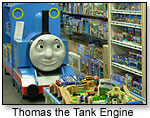 President Cynthia Wyatt’s son, Elston, “absolutely loved his Thomas trains, and that quest to find him his trains extended to other people who saw his trains and wanted me to help them find the trains for their kids, too,” she told TDmonthly Magazine. “At the time, Thomas was relatively unavailable in the U.S. and very difficult to find.”
President Cynthia Wyatt’s son, Elston, “absolutely loved his Thomas trains, and that quest to find him his trains extended to other people who saw his trains and wanted me to help them find the trains for their kids, too,” she told TDmonthly Magazine. “At the time, Thomas was relatively unavailable in the U.S. and very difficult to find.”
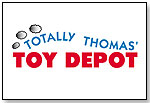 Wyatt formulated a business plan in August 1991 and opened Totally Thomas in June 1992. Beginning as a kiosk in a world-class shopping center and shortly thereafter expanding to a kiosk in a second major mall, over the next three years, Totally Thomas occupied three store locations in the mall, each successively larger to accommodate growth. Wanting to expand its selection into a full-line specialty toy store, in May 1995, the store moved into a shopping center in the Carmel Mountain Ranch community in San Diego’s North County, and Totally Thomas’ Toy Depot was born.
Wyatt formulated a business plan in August 1991 and opened Totally Thomas in June 1992. Beginning as a kiosk in a world-class shopping center and shortly thereafter expanding to a kiosk in a second major mall, over the next three years, Totally Thomas occupied three store locations in the mall, each successively larger to accommodate growth. Wanting to expand its selection into a full-line specialty toy store, in May 1995, the store moved into a shopping center in the Carmel Mountain Ranch community in San Diego’s North County, and Totally Thomas’ Toy Depot was born.
The store’s website was a development of early customer demand.
TOURISTS TALK UP THOMAS
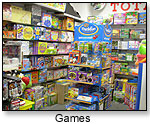 “During our start at a mall frequented by tourists, word was getting out across the country of how we had all this amazing selection of Thomas trains and toys,” spurring the start of the store’s mail/phone order business, Wyatt told TDmonthly. “As this part of our business continued to grow, we added a full-color, Thomas-themed catalog, and in 1995 developed our website. We were one of the very first toy websites on the Worldwide Web.”
“During our start at a mall frequented by tourists, word was getting out across the country of how we had all this amazing selection of Thomas trains and toys,” spurring the start of the store’s mail/phone order business, Wyatt told TDmonthly. “As this part of our business continued to grow, we added a full-color, Thomas-themed catalog, and in 1995 developed our website. We were one of the very first toy websites on the Worldwide Web.”
Traditionally, Totally Thomas’s online sales have significantly exceeded its in-store sales, but it’s “a changing landscape right now”, Wyatt said, since “Thomas is now positioned primarily in the mass market. But this could change. We’ve seen this pendulum swing before.”
Economic and other challenges since 2007, which could have spelled derailment, were a call to action to make crucial business adjustments that keep Totally Thomas chugging happily along.
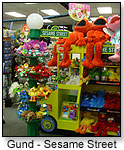 For the 2010 holidays, the store is scrapping its traditional print advertising in favor of building a second website to reflect the large variety of toys in its brick-and-mortar location, and to allocate funds toward integrating its office systems with the two websites and fulfillment channels.
For the 2010 holidays, the store is scrapping its traditional print advertising in favor of building a second website to reflect the large variety of toys in its brick-and-mortar location, and to allocate funds toward integrating its office systems with the two websites and fulfillment channels.
SPECIALTY SUFFERS
Wyatt noted five major problems that have threatened specialty toy retailers over the last few years:
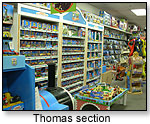 • Movement of specialty products to mass channels
• Movement of specialty products to mass channels
• Rising operating expenses
• Consumer fears over recalls
• The recession
• Uncontrolled Internet discounting on key product lines
When it comes to the last challenge, Wyatt prefers to support manufacturers that have a solid MAP policy — preventing sales below agreed-upon minimums — and enforce it to protect their brand and their retailers, as long as there’s reasonable provision for retailers to close out a product when necessary.
RECALLS AND RECESSION CUT SALES NEARLY IN HALF
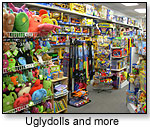 On the heels of the Thomas recalls in 2007, two large anchor stores and a number of major chain stores in their mall closed due to bankruptcy or financial trouble, in 2008. The massive vacancies have completely undermined their once-enviable foot-traffic. Together, those events presented a huge challenge to Totally Thomas’ business, which has seen sales fall by almost 50 percent in the last few years.
On the heels of the Thomas recalls in 2007, two large anchor stores and a number of major chain stores in their mall closed due to bankruptcy or financial trouble, in 2008. The massive vacancies have completely undermined their once-enviable foot-traffic. Together, those events presented a huge challenge to Totally Thomas’ business, which has seen sales fall by almost 50 percent in the last few years.
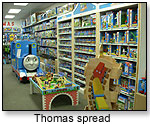 “The year of the recalls alone (2007), our online (primarily Thomas) sales dropped 42 percent, and our in-store sales (which are roughly one-third Thomas) dropped 18 percent,” Wyatt told TDmonthly. The falling economy offset recovering sales moving forward, leaving the store and website at “slightly better than half of what we were doing in sales just prior to the 2007 recalls.”
“The year of the recalls alone (2007), our online (primarily Thomas) sales dropped 42 percent, and our in-store sales (which are roughly one-third Thomas) dropped 18 percent,” Wyatt told TDmonthly. The falling economy offset recovering sales moving forward, leaving the store and website at “slightly better than half of what we were doing in sales just prior to the 2007 recalls.”
But, remarkably, the store's profitability is up. How?
LITTLE CHANGES DO MAKE A DIFFERENCE
To combat the decline in sales, Totally Thomas has implemented the following changes:
• Added Amazon fulfillment, despite its lofty commission requirements.
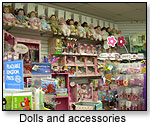 • Decreased warehousing costs by utilizing a state-of-the-art self-storage facility, paying only for the space they need at any given time. The facility staff sign for their shipments, eliminating the need for staffing a second location. Totally Thomas converted its former stock room to a shipping office and added additional storage in back, further lessening the overhead costs of warehousing and staffing at a separate location.
• Decreased warehousing costs by utilizing a state-of-the-art self-storage facility, paying only for the space they need at any given time. The facility staff sign for their shipments, eliminating the need for staffing a second location. Totally Thomas converted its former stock room to a shipping office and added additional storage in back, further lessening the overhead costs of warehousing and staffing at a separate location.
• Increased training for all staff members. Cross-trained staff and consolidated the team to a single location, where employees are taught to handle storefront tasks, sales, shipping, customer service calls, product details and more.
• Stepped up marketing using Constant Contact, Facebook and Twitter.
• Incorporated more high-margin items and committed to closely tracking new price changes. “We looked for items where we could get an extra dollar or more above our usual markup,” Wyatt said, giving Pecoware stationary box sets as an example of where “the perceived value is considerably higher than the standard keystone mark-up.”
• Negotiated EVERYTHING: leases, shipping contracts, supplies, insurance, payroll services, etc. And then renegotiated.
“We’re not using the recession issues as an excuse,” Wyatt emphasized. “Rather, we are treating it as a call to action to improve the way we do business. We intend to be at the very top of our game when the economy comes back.”

